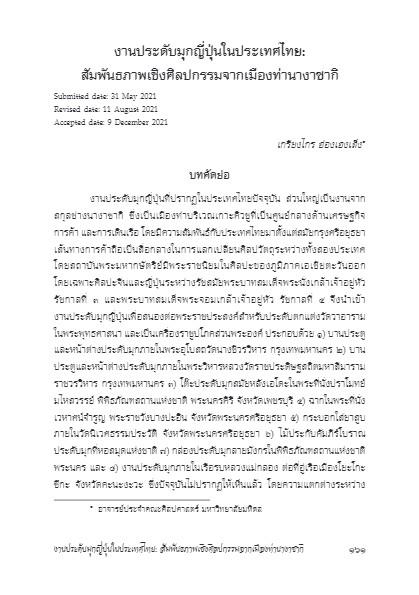งานประดับมุกญี่ปุ่นในประเทศไทย: สัมพันธภาพเชิงศิลปกรรมจากเมืองท่านางาซากิ
เกรียงไกร ฮ่องเฮงเส็ง
บทคัดย่อ
งานประดับมุกญี่ปุ่นที่ปรากฏในประเทศไทยปัจจุบัน ส่วนใหญ่เป็นงานจากสกุลช่างนางาซากิซึ่งเป็นเมืองท่าบริเวณเกาะคิวชูที่เป็นศูนย์กลางด้านเศรษฐกิจการค้าและการเดินเรือ โดยมีความสัมพันธ์กับประเทศไทยมาตั้งแต่สมัยกรุงศรีอยุธยาเส้นทางการค้าถือเป็นสื่อกลางในการแลกเปลี่ยนศิลปวัตถุระหว่างทั้งสองประเทศ
โดยสถาบันพระมหากษัตริย์มีพระราชนิยมในศิลปะของภูมิภาคเอเชียตะวันออกโดยเฉพาะศิลปะจีนและญี่ปุ่นระหว่างรัชสมัยพระบาทสมเด็จพระนั่งเกล้าเจ้าอยู่หัวรัชกาลที่ ๓ และพระบาทสมเด็จพระจอมเกล้าเจ้าอยู่หัว รัชกาลที่ ๔ จึงนำเข้างานประดับมุกญี่ปุ่นเพื่อสนองต่อพระราชประสงค์สำหรับประดับตกแต่งวัดวาอารามในพระพุทธศาสนาและเป็นเครื่องราชูปโภคส่วนพระองค์ประกอบด้วย ๑) บานประตูและหน้าต่างประดับมุกภายในพระอุโบสถวัดนางชีวรวิหาร กรุงเทพมหานคร ๒) บานประตูและหน้าต่างประดับมุกภายในพระวิหารหลวงวัดราชประดิษฐสถิตมหาสีมารามราชวรวิหาร กรุงเทพมหานคร ๓) โต๊ะประดับมุกสมัยหลังเอโดะในพระที่นั่งปราโมทย์มไหสวรรย์พิพิธภัณฑสถานแห่งชาติพระนครคีรีจังหวัดเพชรบุรี๔) ฉากในพระที่นั่งเวหาศน์จํารูญ พระราชวังบางปะอิน จังหวัดพระนครศรีอยุธยา ๕) กระบอกใส่ยาสูบภายในวัดนิเวศธรรมประวัติจังหวัดพระนครศรีอยุธยา ๖) ไม้ประกับคัมภีร์โบราณประดับมุกที่หอสมุดแห่งชาติ๗)กล่องประดับมุกลายมังกรในพิพิธภัณฑสถานแห่งชาติพระนคร และ ๘) งานประดับมุกภายในเรือรบหลวงแม่กลอง ต่อที่อู่เรือเมืองโยะโกะซึกะ จังหวัดคะนะงะวะ ซึ่งปัจจุบันไม่ปรากฏให้เห็นแล้ว โดยความแตกต่างระหว่างงานประดับมุกของญี่ปุ่นและไทยจำแนกได้เป็นด้านวัตถุดิบ ซึ่งยางรักของญี่ปุ่นเป็นสายพันธุ์เดียวกับของจีนและเกาหลีขณะที่ยางรักของไทยเป็นสายพันธุ์เดียวกับเมียนมา ด้านสายพันธุ์ของหอยมุกประเทศญี่ปุ่นนิยมใช้หอยมุกบางสายพันธุ์เหมือน
ของไทย เช่น หอยมุกไฟ หอยงวงช้าง หอยจาน และหอยนมสาว ขณะที่หอยเป๋าฮื้อซึ่งให้สีสันสวยงามจะพบในงานประดับมุกญี่ปุ่นมากกว่าด้านเครื่องมือและวัสดุช่างญี่ปุ่นมีอุปกรณ์พิเศษสำหรับเทคนิคมากิเอะ หรือการโรยผงเงินผงทองให้เกิดความแวววาว ได้แก่ หลอดไม้ไผ่สำหรับเป่า พู่กันหางม้า ช้อนเงินขนาดเล็ก อุปกรณ์
สำหรับเคาะเศษผงโลหะ ด้านเทคนิควิธีช่างญี่ปุ่นมีทั้งการใช้เปลือกหอยแบบหนาเหมือนกับช่างไทยที่นิยมฝังเปลือกหอยมุกลงไปในหุ่นที่มีการสลักหรือฉลุลายไว้ อีกเทคนิคที่เป็นเอกลักษณ์ของญี่ปุ่นคือ การใช้เปลือกหอยแบบบาง โดยวางทาบเปลือกหอยที่ตัดแล้วลงไปติดกับพื้นผิว และด้านลวดลายงานประดับมุกญี่ปุ่นเน้นลวดลายธรรมชาติจำพวกดอกไม้ต้นไม้สัตว์มงคล ทัศนียภาพ และวิถีชีวิตผู้คน ซึ่งได้รับอิทธิพลจากจีน ลัทธิชินโต ลัทธิขงจื๊อ และลัทธิเต๋า ขณะที่ลวดลายของไทยได้รับอิทธิพลจากวรรณกรรม คติความเชื่อทางศาสนา และสถาบันพระมหากษัตริย์
คำสำคัญ: งานประดับมุก, ยางรัก, นางาซากิ
(ตีพิมพ์ใน วารสารไทยศึกษา ปีที่ 18 ฉบับที่ 1 (มกราคม -มิถุนายน 2565) หน้า 161-202)
Japanese mother of pearl inlay in Thailand: The Art relationship from the port city “Nagasaki”
Kriangkrai Honghengseng
Abstract
At the present time, almost all of the Japanese mother of pearl inlay, or “raden”, found in Thailand is from Nagasaki, a port city on Kyushu island, a center of economic and maritime trade routes. The maritime trade under royal patronage was a key factor in the art relationship between Thailand and Japan. The kings of Thailand who had a passion for East Asian art, especially Chinese and Japanese art, were King Rama III and King Rama IV, both of whom ordered Japanese mother of pearl inlay to decorated temples and royal articles of use, including 1) mother of pearl inlay on windows and doors of Ratchapradit Sathitmahasimaram Temple, Bangkok; 2) mother of pearl inlay on windows and doors of Nang Chi Worawihan Temple, Bangkok; 3) mother of pearl inlay on aLateEdoperiodchair in thePramot Mahaisawan Throne Hall, Phra Nakhon Khiri National Museum, Phetchaburi Province; 4) mother of pearl inlay on a partition of the Wehart Chamrun residential hall of Bang Pa-In Royal Palace, Phra Nakhon Si Ayutthaya Province; 5) mother of pearl inlay on a cigarette cylinder box of Wat Niwet Thammaprewat Temple, Phra Nakhon Si Ayutthaya Province; 6) mother of pearl inlay on a pair of long covered plates used to protect palm leaf manuscripts in the National Library, Bangkok; 7) mother of pearl inlay on a round case in the National Museum, Bangkok; and 8) His Royal Majesty’s ship, Maeklong, whichbuilt at the Uraga shipyard, Yokosuka, Japan.There is a difference interms of materialsuse inThai andJapanese mother ofpearl inlay. For Japanese articles, the lacquer is Urushiol, similar to that used in Korea and China. However, for articles made in Thailand, the lacquer is Thitsiol, similar
to that used in Myanmar. Moreover, Japanese articles always use pearl oyster and abalone that is more shimmering, but Thai articles often use pearl oyster,nile top shell and conch. In addition, the technical tools Japanese craftsman use for “makie”, or sprinkled gold and silver metal powder, is made of a bamboo tube, paintbrush, metal spoon and tool for knocking out the metal dusk. With respect to techniques, Nagasaki mother-of-pearl inlay typically uses a thin shell, although in some cases Japanese and Thai mother of pearl inlay are similar in the use of a thick shell inlay technique. Finally, Japanese mother-of-pearl inlay always uses natural motifs, such as flora, trees, birds, viewpoints and people’s way of life. On the other hand, Thai motifs are influenced by Thai literature, Buddhism and the royal institution.
Keywords: Mother of pearl inlay, Lacquer, Nagasaki
(Published in Journal of Thai Studies Volume 18 Number 1 (January – June 2022) Page 161-202)
บทความ/ fulltext :6_Kriangkrai.pdf
